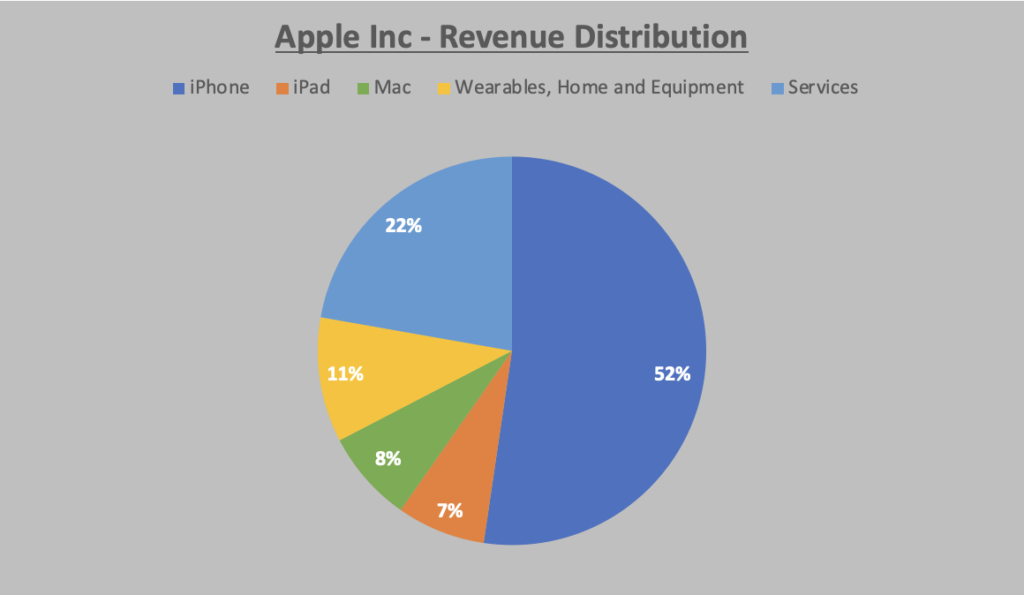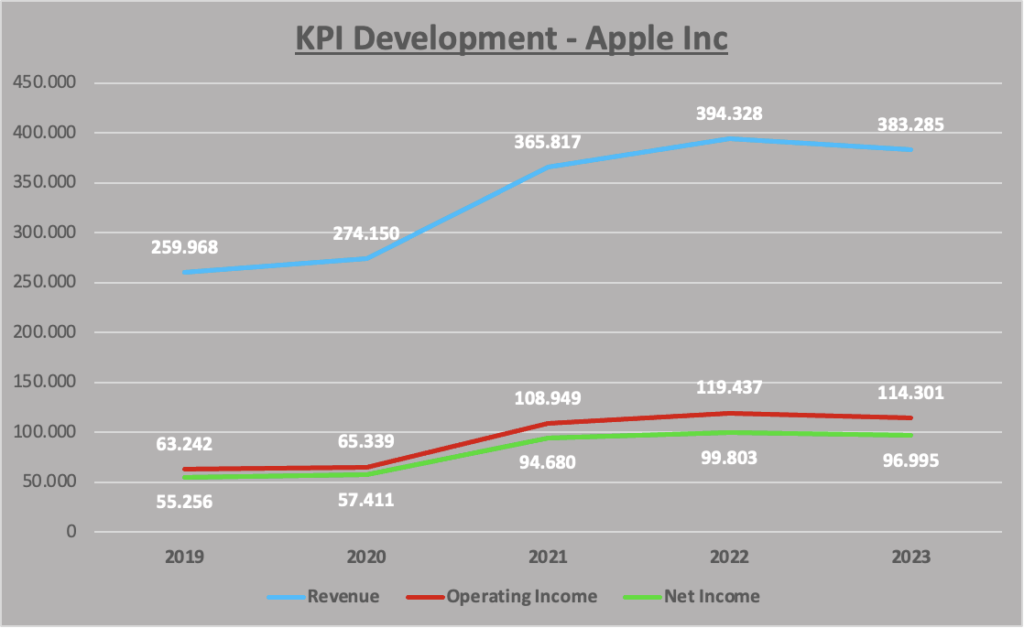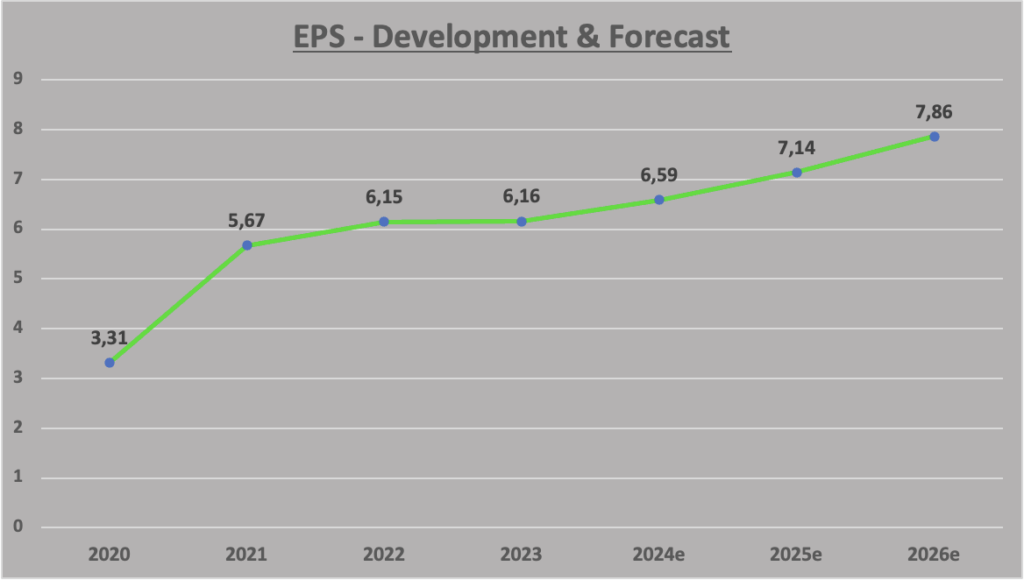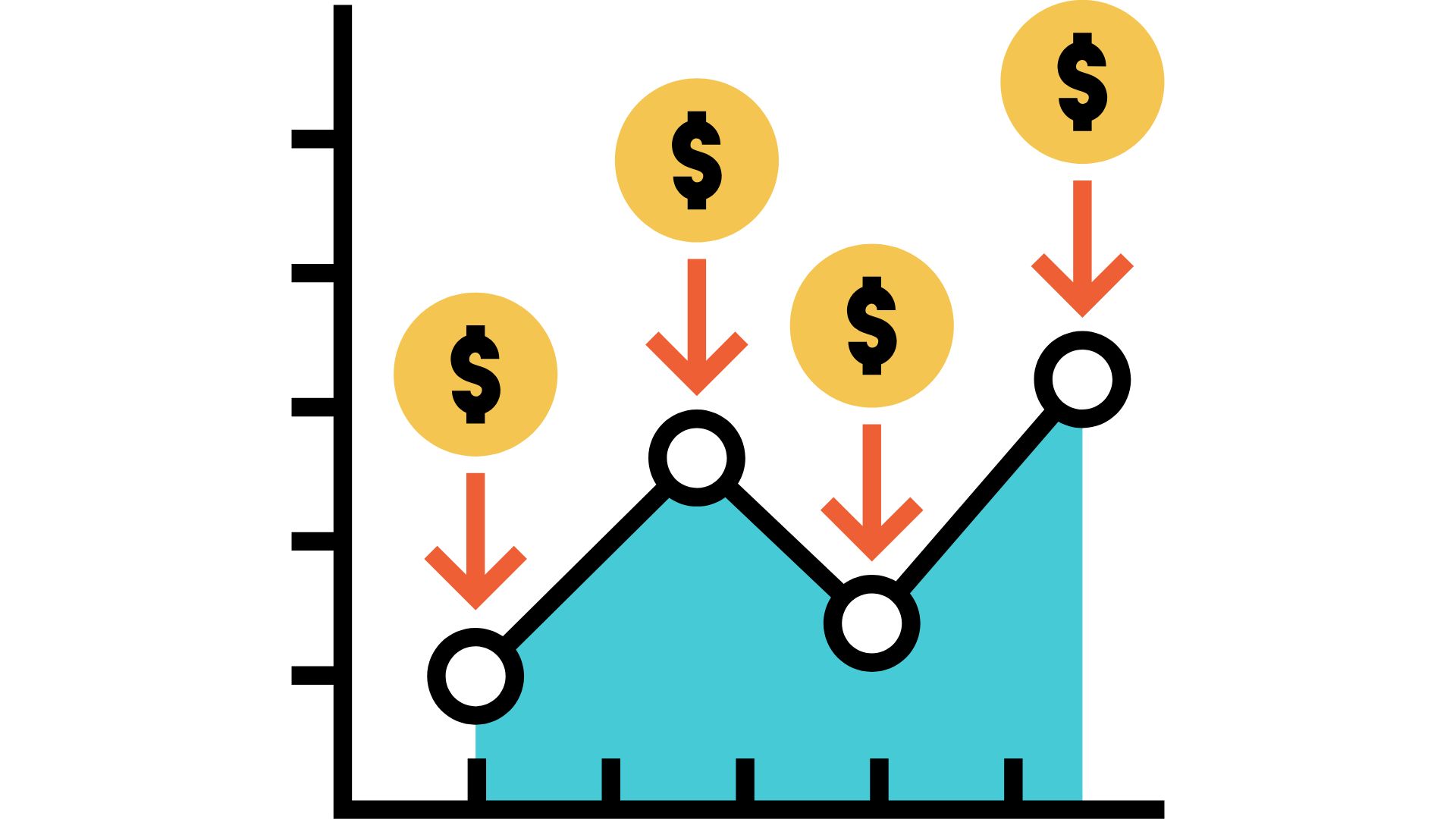In this stock analysis we will learn everything about the Apple share. We will analyze Apple’s profitability, financial security & growth and in the end we will evaluate the share price. You can then decide whether Apple is a suitable investment for you or not.
Company profile
Apple Inc. is an american multinational technology company based in Cupertino, California. The company was founded on April 1, 1976 by Steve Jobs, Steve Wozniak and Ronald Wayne.
Apple is a leading developer and manufacturer of computers, cell phones, consumer electronics, operating systems and application software. The company is also a leading provider of music, movie and television content.
Apple’s products are known for their innovative designs, ease of use and high quality. The company has a strong brand and a loyal fan base.
Here are some of Apple’s key products and services:
- iPhone: The iPhone is the best-selling smartphone in the world. It was introduced in 2007 and has revolutionized mobile technology.
- iPad: The iPad is a tablet computer that was introduced in 2010. It is a popular device for multimedia, gaming and productivity.
- Mac: The Mac is a personal computer that was introduced in 1984. It is a popular device for creatives and professionals.
- Apple Watch: The Apple Watch is a smartwatch that was introduced in 2015. It is a popular device for fitness, health and entertainment.
- Apple TV: Apple TV is a streaming media device that was introduced in 2007. It allows users to stream movies, TV shows and other content from streaming services such as Netflix, Disney+ and Amazon Prime Video.
Apple is an innovative company that is constantly dedicated to new technologies and products. The company has a strong future outlook and is likely to continue to be a leading player in the technology industry.
Revenue Distribution – Apple Inc
Apple’s revenue is made up as follows:
- iPhone: 52,3%
- iPad: 7,4%
- Mac: 7,7%
- Wearables, Home and Equipment: 10,4%
- Services: 22,2%

The most important revenue driver for Apple is the iPhone, followed by Services and Wearables, Home and Accessories.
Apple’s services include music, movies, television, subscriptions, cloud services and other digital content. This area is very profitable for Apple and is growing steadily.
The Wearables, Home and Accessories product group is dominated by the Apple Watch and the various Apple AirPods. Other products such as the Apple TV, HomePod, chargers and other accessories only account for a small proportion of sales.
Apple’s sales distribution is very favorable for the company. The iPhone is by far the most important product and accounts for the majority of sales. It is the heart of the Apple ecosystem and contributes significantly to the company’s success. The iPhone is an innovative and popular product that is characterized by its design, user-friendliness and high quality.
Apple’s revenue distribution is relatively stable. In recent years, the iPhone’s share of total sales has hardly changed. This shows that the iPhone is a very successful product that will continue to sell well in the future.
The Services segment is growing steadily. The Services segment is very profitable for Apple and is growing steadily. This is a positive trend for Apple, as revenue from services is less susceptible to fluctuations than revenue from hardware.
Competition
Apple’s biggest competitors are primarily other technology companies that offer similar products and services. These include:
Samsung: Samsung is the largest smartphone manufacturer in the world and Apple’s biggest competitor in the cell phone sector. Samsung offers a wide range of smartphones, including flagship models such as the Galaxy S23 and more affordable models such as the Galaxy A53.
Google: Google is a leading provider of online services and mobile operating systems. The company offers the Android operating system, which runs on most smartphones.
Xiaomi: Xiaomi is known for its innovative products that are offered at an affordable price. The company has quickly become one of the largest technology companies in the world in recent years and is now the third largest smartphone manufacturer in the world.
Lenovo: The company was founded in 1984 and is the largest personal computer manufacturer in the world. Lenovo offers a wide range of personal computers, including desktop computers, laptops, tablets and smartphones.
Profitability – Apple Inc
The first analysis to determine the intrinsic value is profitability.
Stocks with a competitive advantage generate high profit margins, do not require a lot of capital and stand out from the competition. In other words, stocks with a competitive advantage are more profitable than the competition.
To determine this, we first look at the income statement, analyze it, compare the profit margins with the competition and calculate how capital-intensive the business is compared to the competition.
To do this, we take a closer look at the income statement and start by analyzing how much revenue was generated, what costs accrued and what profit were achieved as a result. Here is the income statement stream from Apple:

Apple generated revenues of around $383 billion in 2023, with around $214 billion in cost of goods sold. The approximately $55 billion in operating expenses are made up almost equally of administrative and research & development costs. The non-operating costs are marginal and have no impact on profits. After taxes, Apple generated a profit of $97 billion.
Profit Margins
The various margins are of particular interest in the income statement analysis. The higher the margins compared to the competition, the greater the competitive advantage. The emphasis here is on competitive comparison, as companies from the automotive industry cannot be compared with technology companies such as Apple. A comparison only makes sense if the products and services are comparable.
Apple achieves better margins than its competitors:
| Apple | Samsung | Alphabet (ex Google) | Xiaomi | Lenovo | |
| Gross Margin | 44,13% | 30,09% | 55,88% | 20,15% | 17,26% |
| Operating Margin | 29,83% | 3,08% | 26,51% | 4,38% | 3,52% |
| Net Profit Margin | 25,31% | 12,28% | 22,46% | 6,02% | 1,77% |
Margins from the income statement give us an indication of the profitability of a company. Basically, it can be said that the better the margins compared to the competition, the higher the profitability and the greater the competitive advantage.
However, as already mentioned, the products and services must be comparable with each other. Even if there are many overlaps in this competitive comparison, they are all unique and a comparison should only be made with caution. As a rule of thumb, it can be said that operating margins of 20% or more and net profit margins of 15% or more are good.
Return on Assets
Return on assets (ROA for short) is the most important key figure for analyzing a company’s profitability. ROA is calculated by dividing the profits by the total assets. It shows how much profit a company generates from its assets. The higher the ROA compared to the competition, the better the company’s earning power.
An example to illustrate this: Let’s assume you have $500,000 to buy a rental apartment. You can choose between two apartments: The first apartment costs $500,000 and brings in $12,000 in rental income per year. The second apartment also costs $500,000 and brings in $18,000 in rental income per year.
The ROA for the first apartment is 2.4 % and 3.6 % for the second apartment. This means that you generate more income from your invested capital with the second apartment.
Here is the ROA comparison between Apple and its competitors:
| Apple | Samsung | Alphabet | Xiaomi | Lenovo | |
| ROA | 28,21% | 7,15% | 17,82% | 5,63% | 2,43% |
As already mentioned, the comparison is very complex because only similar products and services can be compared with each other. Apple, which generates the most revenue from hardware products, would have to be compared with companies that also generate the most revenue from them. Accordingly, the comparison of Apple’s ROA with Samsung, Xiaomi or Lenovo is the most meaningful.
Financial Security – Apple Inc
After analyzing the profitability, the second analysis for determining the intrinsic value is the financial security of a company. This is because companies that are financially secure and solidly financed give us investors a level of security. While the income statement provides us with information about the operating business, the balance sheet shows us how the company is financed.
To assess the financial security of a company, it is important to look at the ratio between equity and debt. In addition, the company should be able to cope with short-term financial burdens. The debt to equity ratio and the cash ratio are two key figures that can help us with this.
The debt to equity ratio shows the relationship between long-term debt and equity. The cash ratio shows how well short-term liabilities are covered by cash, bank and similar assets. Here is the development of the mentioned KPIs for Apple:
| Cash Ratio | Debt to Equity | |
| 2020 | 0,86 | 1,72 |
| 2021 | 0,5 | 1,98 |
| 2022 | 0,31 | 2,37 |
| 2023 | 0,42 | 1,79 |
This means that current liabilities are not well covered and the company is largely financed by debt. This is an indicator of a low level of financial security. To put financial security into perspective, here is a comparison with the competition:
| Apple | Samsung | Alphabet | Xiaomi | Lenovo | |
| Cash Ratio | 0,42 | 1,47 | 1,64 | 0,76 | 0,17 |
| Debt to Equity | 1,79 | 0,03 | 0,12 | 0,17 | 0,78 |
As can be clearly seen in this comparison, Apple has a low level of financial security. Compared to its competitors, its short-term liabilities are almost the worst secured and its debt-to-equity ratio is by far the highest.
Growth – Apple Inc
Analyzing company performance is an important part of value investing. It makes it possible to draw conclusions for the future from the past. The income statement provides important information about the development of the company.
Here is the development of revenue, operating income and net income from 2019 to 2023:

In the period from 2019 to 2023, Apple achieved an increase in revenue of +47%, with an operating growth of +81% combined with a profit increase of +76% to around $97 billion.
Apple’s growth compares favorably with the competition:
| 2019 to TTM | Apple | Samsung | Alphabet | Xiaomi | Lenovo |
| Revenue Growth | +47% | +2% | +84% | +27% | +9% |
| Operating Growth | +81% | -73% | +119% | +34% | +35% |
| Netto Net Income Growth | +76% | +34% | +94% | +56% | +35% |
The development of KPIs can provide information about the future development of a company. Although past growth is no guarantee of future growth, companies with a strong performance will generally continue to grow in the future. Companies whose sales and profits are falling, on the other hand, will generally also fall in the future.
To make a more accurate forecast, you should also consider the distribution of sales in addition to the KPI development. Apple generates the most revenue with iPhones/smartphones, followed by services.
Share Price & Forecasts
Now that we have analyzed and evaluated the Apple share, it is time to assess the current price of the share.
The share price is determined by supply and demand. Supply is determined by the company and the shareholders. Demand is determined in the long term by the earnings per share. The more profit a share generates, the more interesting it is for investors.
The P/E ratio, also known as the price/earnings ratio, shows the relationship between the share price and the earnings per share. For example, a P/E ratio of 20 means that a share with a price of $20 has earnings per share of one dollar. (Price = P/E ratio * earnings per share)
The lower the P/E ratio, the better the investment. Unfortunately, this cannot be said across the board, as future developments and forecasts play a very important role. Let’s come back to our example:
We currently have a P/E ratio of 20 and an earnings per share of one dollar.
In the first scenario, we assume that the company will generate earnings per share of $3 next year and even more in the following years. The future prospects are therefore very good, and if this is the case, demand will probably increase.
The second scenario is exactly the opposite. Future expectations are poor and the company is expected to generate only $0.5 per share in the coming year and the following years do not look much better. Here, the share price of $20 is probably too high for many investors and demand is falling.
In the last scenario, it is expected that the company will no longer achieve growth and will remain at a profit of $1 per share in the coming years. The $20 is perhaps just the right price and a stable share for the future.
The various scenarios are purely hypothetical and only reflect reality to a certain extent. But the basic idea between earnings per share, P/E ratio and share price should have been well illustrated.
Earnings per Share – Apple Inc
Let’s take a look at the development and forecasts for Apple’s earnings per share (EPS):

EPS of $6.59 is expected for 2024 and the expected values for 2025 and 2026 also mean a significant increase in earnings. With the base value of 2023, Apple would achieve an increase of +27.6% to $7.86. Based on our analysis, this growth seems plausible. But earnings per share are only half the story, let’s look at the P/E ratio.
P/E Ratio Development – Apple Inc
Here is the development of Apple’s P/E ratio from 2019 to 2023:

A P/E ratio of less than 20 is considered undervalued, a P/E ratio of more than 25 is considered overvalued. Apple has a P/E ratio of 27.91. This would mean that the share is slightly overvalued.
Over the entire period, Apple’s average P/E ratio is around 26.3, which basically means it is slightly overvalued. To get a more accurate valuation, we should link the P/E ratio with EPS.
Share Price – Forecast
First, we link the EPS forecasts with Apple’s P/E ratios. In the first scenario, we assume that demand for Apple shares will remain the same over the next few years. This would result in the following share price forecasts:
| Year | EPS-Forecast | P/E Ratio | Share Price – Forecast |
| 2024e | 6,59$ | 26,3 | 173$ |
| 2025e | 7,14$ | 26,3 | 187$ |
| 2026e | 7,86$ | 26,3 | 206$ |
Apple’s share price currently stands at $192.02 (as of 29.12.23). Based on this scenario, Apple’s share price performance looks okay. To be precise, an increase in value of around 7.3% until 2026.
In a second scenario, we expect demand to be conservative, so we assume a P/E ratio of 20-25, which can generally be considered fair.
| Year | EPS-Forecast | P/E Ratio | Share Price – Forecast |
| 2024e | 6,59$ | 20-25 | 131-164$ |
| 2025e | 7,14$ | 20-25 | 142-178$ |
| 2026e | 7,86$ | 20-25 | 157-196$ |
In this scenario, Apple would experience little to no increase in value.
I would not recommend a third scenario with rising demand, because you should always allow for a margin of safety when making forecasts, as the future is uncertain.
Dividends
Apple distributes part of its profits to its shareholders. These are known as dividends. It is highly popular with shareholders, but should always be viewed with caution. After all, if the company distributes profits, this may be nice for shareholders, but the capital is not available for investments and growth projects. Dividends are therefore an indication of stagnating growth.
Here are the past dividends per share and the current forecasts for the coming years:

At the current price of $192.02 (as of 29.12.23), this means a dividend yield of less than one percent, and no growth is to be expected. If you are looking for a profitable dividend investment, Apple shares are not the right choice.
Summary
The share analysis comes to the following conclusions:
- Profit margins: Apple achieves very high profit margins. In 2023, the operating margin was 29.83% and the net profit margin was 25.31%.
- Growth: In the last five years, Apple has achieved revenue growth of 47% and profit growth of 76%
- Debt: Apple is burdened with a high level of debt. The debt-to-equity ratio was 1.79 in 2023.
- Brand: Apple has one of the strongest brands in the world. The company enjoys a high level of trust and loyalty among its customers.
- Customer base: Apple has a loyal fan base that is willing to pay more for Apple products.
- Innovation: Apple is an innovative company that is constantly bringing new products and technologies to the market.
- Competition: Apple is facing increasing competition. In the smartphone sector, the company is up against Samsung and other manufacturers.
Based on the analyses, Apple is a solid company with good prospects for the future. Apple’s shares are slightly overvalued at the current valuation level. But what do you say?
Disclaimer
This article is not financial advice and does not constitute a recommendation to buy or sell stocks. The information in this article is based on the personal opinions of the author and should not be construed as investment advice.
The author assumes no liability for any damages resulting from the use of the information in this article. Readers should inform themselves independently before investing in stocks and only make an investment decision after their own examination. An investment in shares can lead to a total loss of capital.
All figures on Apple and the share are from Gurufocus.
Gurufocus offers a comprehensive and intuitive platform that simplifies our work as value investors. With comprehensive financial data and a stock screener with more than 500 filters, you can quickly find the right stocks and analyze them immediately. It is my absolute go-to tool for my stock analysis and you can test it for 7 days free of charge and see for yourself.



